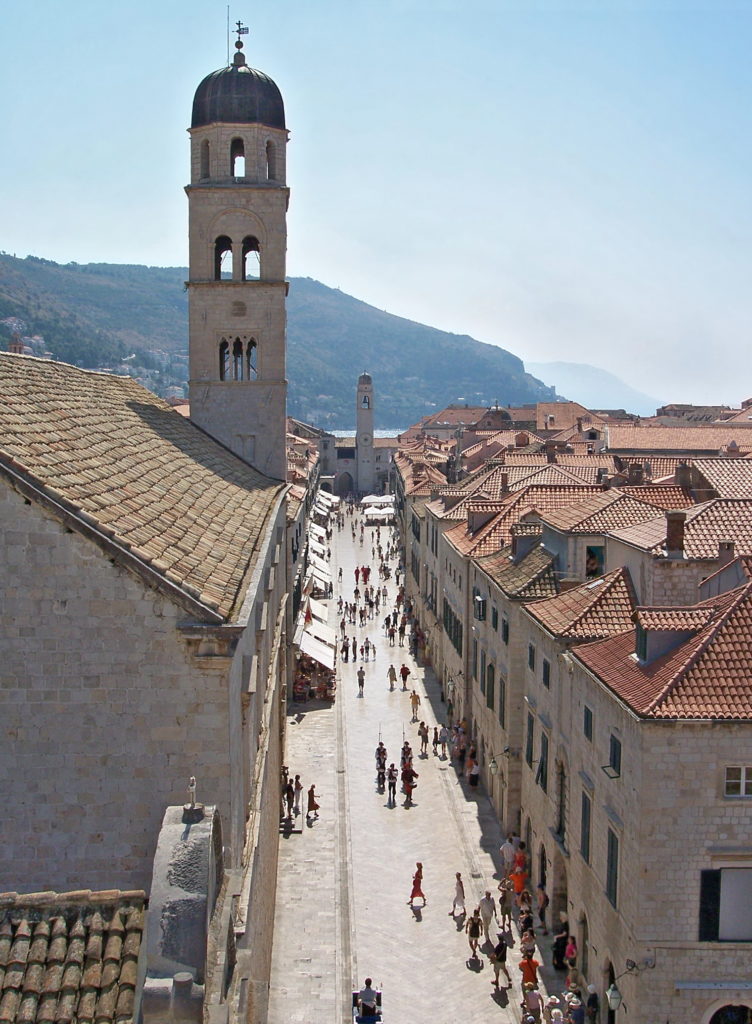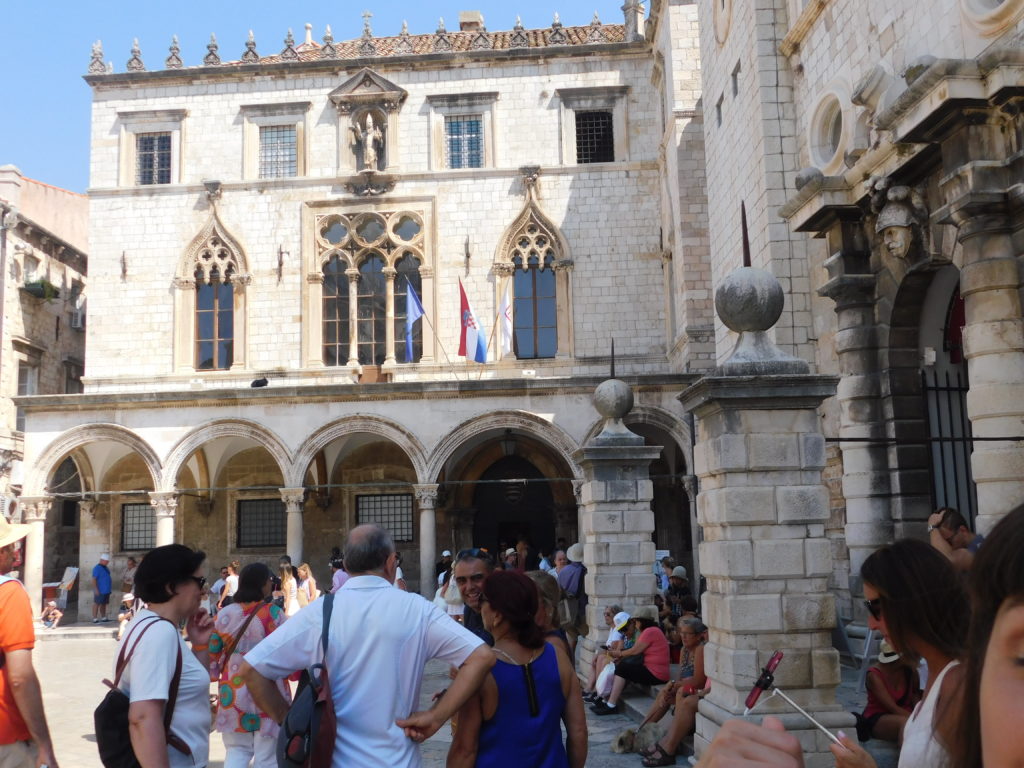A bit of a city walk.
Dubrovnik differs from the many European cities that have long pedestrian streets in the sense that, for the most part, the entirety of the old city itself is a pedestrian only zone. Almost none of the city’s streets are wide enough to accommodate motor vehicles (other than, perhaps scooters). For example, here’s a photo of the Stradun from the city wall taken later in the day.
And this is of the city’s next widest street called, appropriately enough, Broad Street:.
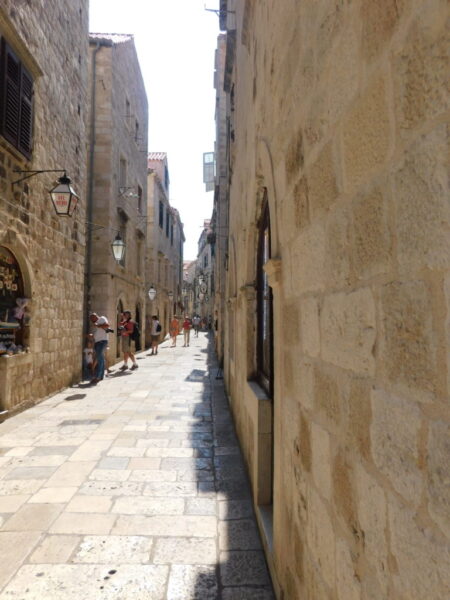
I hope this shows that the city’s second widest street is, at best, a tight fit for a car or van.
On our morning tour, we visited or walked past several other sites of possible interest such as the Convent of Sveta Klara (Saint Claire) which was constructed at the end of the 13th and beginning of the 14th centuries. An orphanage for abandoned and illegitimate children established between 1432 and 1434 in a section of the convent was among the first of its kind in Europe and, according to our guide, saved many illegitimate children from infanticide.
We also visited the Rector’s palace – so named because it served as the seat of the Rector of the Republic of Ragusa between the 14th century and Napoleon’s conquest of this territory in 1808. It was also the seat of the Minor Council and the state administration. Rectors were chosen from the council which was made up of the local nobility and each served a one-month term.
The building has also served as a prison and an armory and, while being used as the latter, was badly damaged by a gunpowder explosion in 1463. Like most of Dubrovnik, the building was destroyed in the 1667 earthquake and rebuilt in the Baroque style. It has housed a history museum since 1872. I noted this spot of whimsy in the Rector’s Palace.
The tour’s end put us at the opposite end of the street from the Rector’s Palace – Luža Square. The highlights of this area are the Sponza Palace and the small Onofrio’s Fountain. This fountain, like its larger counterpart, is still a popular watering spot.
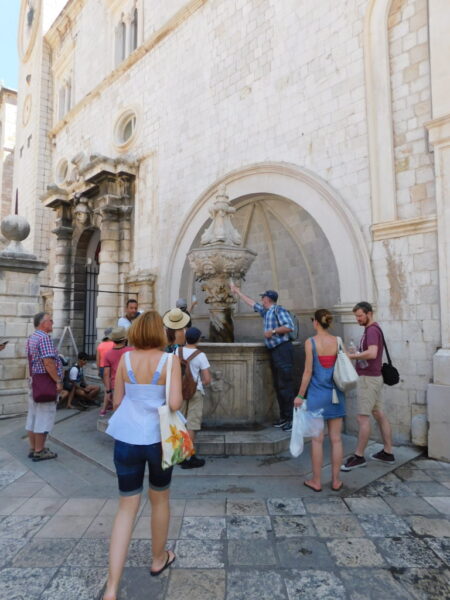
The Sponza Palace, like the Church of Saint Saviour, largely survived the 1667 earthquake. Today, it houses a memorial to the defenders killed during the nineties wars but it’s had numerous uses over the centuries including serving as a customs office and bonded warehouse, a mint, an armory, a treasury, a bank, and a school. It also became the cultural center of the Republic of Ragusa with the establishment of the Academia dei Concordi, a literary academy, in the 16th century.
The palace’s atrium served as a trading center and business meeting place. An inscription on an arch testifies to this public function:
Fallere nostra vetant et falli pondera. Meque pondero cum merces ponderat ipse deus.
“Our weights do not permit cheating. When I measure goods, God measures with me.”
To reinforce that notion, in the center of Luža Square stands a Gothic style statue of Orlando (Roland) a legendary freedom figure throughout Europe here symbolically representing the city’s independence. The statue’s forearm stood as an ell or the standard of measure for the Republic of Ragusa. However, buyers wishing to test the honesty of traders in the atrium didn’t have to climb the statue to measure their goods. Instead, they simply had to lean down.
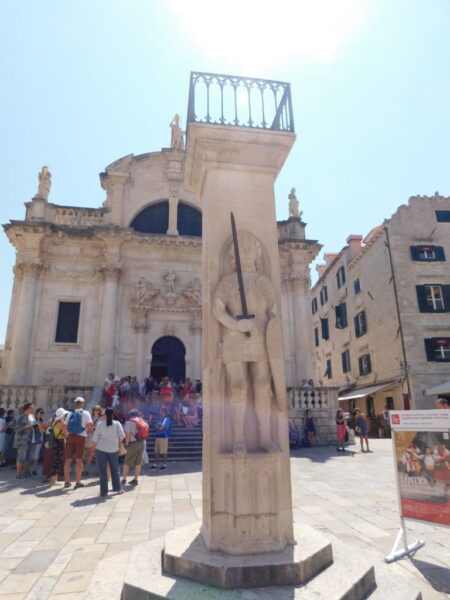
This information ended our guided tour and we were left to explore the city on our own. Four of us – Diane, Judy, Pat, and I set off to find a bite to eat. I’d like to say I remember the name of the restaurant where we had lunch but I can’t recall it even after searching Trip Advisor. I do remember that I had a very tasty squid salad and a beer. After lunch we set off to explore the highly touted Ethnographic Museum. Sadly, despite assurances from both the city guide and Damir, we discovered that the museum was closed on Tuesdays – the day of our visit.
Since we had a city pass that admitted us to most of the attractions requiring an entrance fee and because we, like all wise walkers, wanted to wait until the height of the heat of the day to walk the wall, we decided to first visit the Maritime Museum. Like much in Dubrovnik, it was small but surprisingly interesting.
I’m going to break the post here and hold my coverage of the wall walk (and finding that Kodak-ee moment) to take a brief detour into some serious material including the history of Jews in Dubrovnik and a bit about what transpired in the period between 1991 and 1995.
